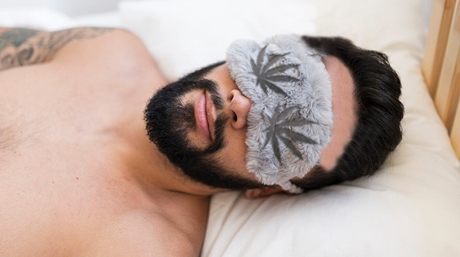Our beloved Cannabis plant effectively restores a person’s sleep, which often falls out of sync with current schedules. Whether you have a sleep disorder, a messed up sleep cycle, or need help sleeping after a stressful day; marijuana can improve your sleep issues.
If you have trouble falling asleep, weed can help you fall and stay asleep. CBD, a compound in weed, has been shown to promote sleep by binding to receptors in the brain that regulate sleep and wakefulness. THC, another compound in weed, can also help you fall asleep by reducing anxiety.
If you’re one of the millions who suffer from sleeping disorders, you may be interested in trying cannabis as a treatment. Marijuana is an effective sleep medicine for deeper and better sleep, with few side effects.
Around 70% of young adults that regularly use cannabis, report that they use it for a good sleep. About half of the long-term weed users, or those who have been using marijuana for at least 10 years, report using weed to improve sleep quality. Of those who use weed for medicinal purposes, 85% of them report that marijuana improves their sleep quality and sleep cycles.
In terms of marijuana research aiding users to obtain quality sleep and assisting in other sleep disorders, studies about it continue to prosper and are developing.

In this article, we are going to take a closer look at how cannabis works and helps users obtain a deep sleep, how effective it is, which type of weed you should use, different ways to consume it, and other deliberation to consider before finalizing your thoughts about pot use for a good sleep.
The effects of utilizing weed have always been case-to-case. Cannabis may help people or medical patients going through nightmares caused by PTSD or posttraumatic stress disorder and other issues that make people experience difficulties in falling asleep and enjoying a rejuvenating rest.
cannabinoids which are commonly found in cannabis, work by interacting with the receptors in our brains. By binding with the brain’s receptors, cannabinoids gain control of some bodily functions by suppressing the brain’s arousal system.
These two are the most common and famously known by many due to their contrasting effects on the body. THC typically has sedative effects, but it can also be stimulating for some, especially for those trying marijuana for the first time. CBD promotes alertness at lower doses and sleepiness at higher doses. CBD and THC compounds may offer varying results depending on how they are used.
Both THC and CBD aid chronic conditions that may interfere with sleep. THC can be effective on patients who experience PTSD-related nightmares and sleeping troubles, while CBD can help regulate body temperature and synchronize sleep patterns.
Weed has been used to help with sleep problems for centuries. The first recorded cannabis use for sleeping dates back to 2737 BC when the Chinese Emperor Shen Nung recommended the plant for its ability to “induce sleep and relieve pain.” In the past centuries, marijuana has been used as a sleep resource by cultures worldwide. In India, for example, the Ayurvedic tradition has long recommended weed for insomnia and to fall asleep.
While the use of cannabis as a sleep medicine has a long history, its scientific study is relatively new. In the past few years, however, a growing body of research has begun to explore the potential of marijuana for treating insomnia and improving sleep.
One of the most promising research areas is cannabidiol (CBD) for sleep. CBD is a non-intoxicating compound found in cannabis, and preliminary research suggests that it may have several potential health benefits, including improved sleep.
A 2019 study published in The Permanente Journal found that CBD was effective in reducing insomnia symptoms in people with chronic pain.
There are many benefits to marijuana use as a sleep aid. Cannabis can help to restore a person’s sleep cycle, which often falls out of sync with current schedules. Additionally, weed effectively relieves pain and reduces anxiety, which can contribute to insomnia. Cannabis is also a safe and non-addictive help, with few side effects. In contrast, many of the commonly prescribed drugs, such as benzodiazepines, are addictive and come with a host of dangerous side effects.
Cannabis is a relatively inexpensive sleep aid, especially compared to prescription medications’ cost. You can grow your own! Additionally, there are many different ways to consume pot, so people can find the method that works best for them.
The most common is that it can disrupt REM sleep, leading to daytime grogginess. Additionally, some people may build up a tolerance to marijuana, requiring them to use more and more of the substance to get the same effect. However, this is typically a concern for people who use weed frequently.
All in all, the pros of using marijuana as a sleep medication far outweigh the cons. If you are struggling with insomnia, you won’t have a rem sleep anyway, so give it a try!
If you’re interested in using cannabis as a sleep aid, keep a few things in mind. First, it’s important to start with a low dose and increase gradually as needed. It’s also important to research what works best for your sleep problems. It might be a high THC Strain or a CBD strain.
As a controlled substance, studies about cannabis, especially on safety consumption and its effects on people having trouble in their sleeping cycle, are still limited. However, compared with other prescribed medications and FDA-approved products or over-the-counter sleep medications, pot is still highly preferred by most patients, and independent individuals as other forms of medications are most likely associated with a high risk of abuse, tolerance, or various side effects.
Some other natural sleep aids, like oral melatonin, appear to reduce insomnia without strong side effects, while other homeopathic options still need more research. Despite this, many patients with insomnia and other sleep disorder symptoms refer to cannabis as an effective treatment with little to no side effects.
Unlike other sleeping medications, pills, or remedies available on the market today, cannabis has proven to show more efficacy in addressing poor sleep or other issues, especially for people who often are out of sync with the body’s natural circadian rhythm due to our modern lifestyle. We all know how hard it is to fall asleep while the mobile phone is close by with all the news in the world at arm’s length.
Cannabis contains over 100 chemical compounds, including THC and CBD. However, most of the research on marijuana and sleep has been conducted using THC-rich strains. THC is the psychoactive compound in weed that produces the “high” feeling. CBD, on the other hand, is non-psychoactive and does not produce a high.
A small body of research has found that THC may effectively treat insomnia. A 2006 study found that THC effectively reduced the time it took to fall asleep and increased sleep duration in people with insomnia. A 2013 study also found that THC improved sleep quality in people with PTSD.
Smoking is a known health risk and should be cautiously approached. Cannabis, a controlled substance, is still illegal in many states and territories despite its medicinal benefits.
However, some states allow the use of weed solely for medicinal purposes, and if your professional physician approves the use of it to treat your insomnia. For others, you have to research your symptoms, is the issue of falling asleep, shallow sleep, or different insomnia strains will work better?
There are different strains of weed, and each variety of strains produces different and varying effects. Here are the three most common weed strains you will encounter:
This type of cannabis strain is considered soothing and relaxing. It may help produce feelings of drowsiness and sleepiness. People prefer Indica for their physical effects.
Sativas make people more alert, excited, happy, and energized. While most people consider Indicas the best marijuana strain for sleep, many prefer Sativas to avoid nightmares. While there is a wide difference in the effects of Indicas and Sativas, those dissimilarities do not hold much value other than the differences in THC content and other ingredients included in a particular product.
Hybrid strains with a mix of Indicas and Sativas offer varying effects to their users depending on the specific composition of cannabinoids and other active compounds. Some hybrids are more Indica-dominant which offers a soothing effect, while the others are Sativa-dominant which offers an energizing and uplifting effect.
Here are some of the best strains to use for insomnia; some are High THC strains, moderate, and CBD.
A Sativa-dominant hybrid known as a high THC strain that relaxes users.
An Indica strain with a high THC level is known for its soothing effects.
A Sativa-dominant hybrid with a moderate THC level that provides a balanced high can help users relax without making them too tired.
A Sativa-dominant hybrid with a high CBD level and a moderate THC level.
Before jumping to your final decision of having cannabis to improve your sleep, consulting your healthcare provider’s guidance and professional advice is highly recommended. As they best know your current medical condition and history, they can provide you with sound medical advice best fitted for you.
Keep in mind that long-term usage may countereffect the goal you are trying to achieve. Our body can develop a tolerance for the sedative effects lowering the marijuana efficacy, and a higher dose for the same result might be needed. Long-term marijuana use in high dosages may result in sleep disturbances bringing you back to where you started!
When picking the variety of weed you are taking for the very first time, focus on which forms of weed you want to utilize for your sleep. Your choice will also decide when is the right time to use them to experience their effects when you need them.
When you smoke weed, you can generally feel the immediate effects, while edibles take a longer time as they need to be fully digested first.
When opting for inhalation, effects also depend on the number of times it is inhaled, the length of inhalation, and other contributing factors. Most commonly, THC content boosts its effects approximately in 10 minutes.
Thus, timing is important when you want to use weed for a good night’s sleep. While everyone’s physiology is different, and there is no one-size-fits-all solution to this, using weeds an hour or two before bedtime is the most common to have a well-rested night.
Cannabis can be consumed in various ways, either by inhalation through smoking and vaporizing and oral or by placing it under the tongue as a tincture. Each format has its fair share of benefits and drawbacks.
For example, those who are more concerned about the effects of inhalation or smoking on lung health may prefer to avoid smoking it. Different forms of weed offer different bioavailability or how much of the active THC content you can expect to make it into your bloodstream. Inhalation tends to have high bioavailability as THC enters your system directly.
Knowing how much marijuana for sleep you need to consume requires some knowledge and research. Different strains will also have different amounts of cannabinoids like THC levels and CBD levels on them. Thus, offering varying effects on the body and mind. Timing, dosage, along with one’s regular cannabis use and level of experience, matter when it comes to the amount needed.
Consuming more than you can lead to a person tossing and turning with weed-induced paranoia. It is better to pace your weed intake and be aware of the cues from your body. It is imperative to know your limits and never go beyond that limit.
Cannabis use may have other possible effects besides deep sleep. THC is a component that has other effects besides promoting sleep; you may feel sleepy, relaxed, euphoric, or energized when consuming it. If this is your first time trying it, you may have to experiment a bit before you find the right format, dose, and timing that best works for you.
There is no clear answer as to whether weed or Zolpidem (Ambien) is better for sleep. Both have their pros and cons. Weed is a natural remedy with few side effects, but controlling the dose cannot be easy. Ambien (zolpidem) is a synthetic drug that is effective in inducing sleep, to have some pain relief when suffering from migraines but it can be addictive and has several side effects. Ultimately, it’s up to the individual to decide which is best for them. I prefer natural products over synthetic drugs as they tend to be more gentle on the body and won’t give you any withdrawal symptoms.
Weed has been used as a sleep aid for centuries, and there are many benefits to doing so. Cannabis can help a person fall asleep faster, improve their natural sleep cycle, and give you better sleep. It is effective in treating several sleeping disorders, but to get it right, there is a learning curve that might take some experimentation. Do consider that it’s not a solid long-term solution. If you have severe symptoms, please consult a doctor.
In short, Only you can decide that you want to invest the time and the possible effects like disturbed sleep and anxious feelings are worth it to get a good night’s rest!
We hope you can sleep tight soon again, and as always, Happy Growing!













Related Posts

There is pretty much a strain for everything now and I think that it is pretty fantastic how cannabis has been developed so much that we can now pick and choose how we want to feel and then select a strain from there. Different people have different uses for cannabis, some like it to make them sleepy, others use it to stimulate their appetite, some even use it to enhance their concentration. However, if all you’re looking for is to feel good and maybe a little bit giggly, then this is the article for you. Here are a few of my favorite strains for inducing euphoria:

Welcome to the exciting world of cannabis and cryptocurrency! BTC and marijuana make the perfect match, offering a seamless and secure way to purchase weed seeds and accessories.

The world of CBD (Cannabidiol) is as vast and varied as the benefits it is believed to hold. Among the many forms of CBD products available, three stand out for their unique properties: Full-Spectrum CBD, Broad-Spectrum CBD, and CBD Isolate. They differ mainly in their composition of cannabinoids, the biologically active compounds in the Cannabis Sativa plant.
Full-Spectrum CBD retains…